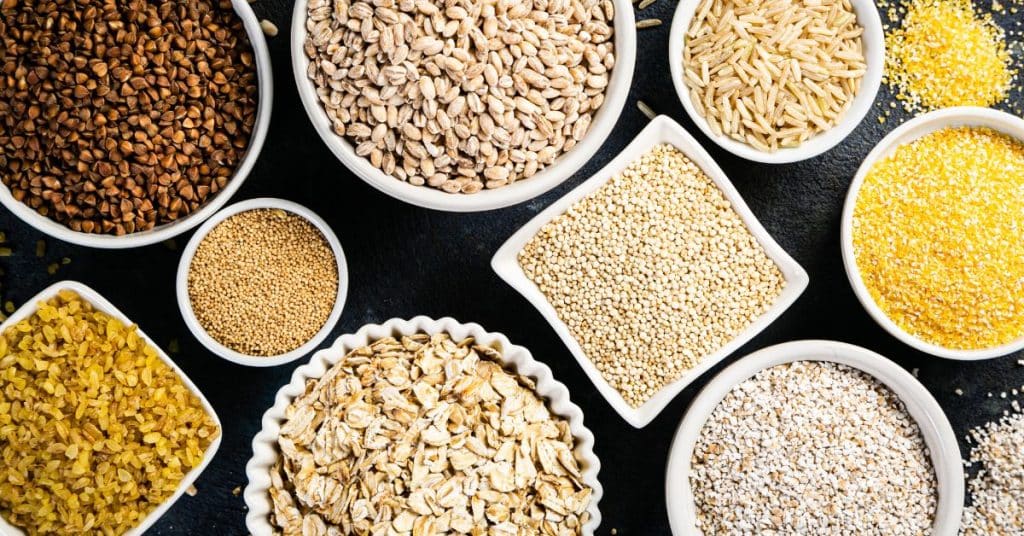

Whole-grain foods support good health, reducing the risk of digestive disorders, heart disease, high cholesterol, high blood pressure, type 2 diabetes, obesity, and certain cancers. Whole grains are high in complex carbohydrates and fiber that help us fill up and delay hunger. This makes them especially effective at controlling weight compared to high-calorie foods. [1][2]
Grains are the seeds of plants, and whole-grain foods include all three parts of the seed:
Whole grains include numerous other nutrients and nutrient-like substances: tocopherols, beta-carotene, vitamin C, folate, glutamine, phytoestrogens, lignans, flavonoids, oligosaccharides, inositol, phenolics, saponins, lectins, and protease and amylase inhibitors. These nutrients may prevent diseases, lower blood cholesterol, stabilize blood sugar, and improve immune function.[1][2]
Fiber is the part of plant-based foods that the body does not digest. Whole grains have both soluble and insoluble fiber. Oats, barley, and rye have soluble fiber, which slows stomach emptying and nutrient absorption, reducing the rise in glucose and insulin to improve blood sugar control. Bran has insoluble fiber, which adds bulk to stool and shortens transit time through the colon. [1][2]
Refined grains, such as white rice and white flour, contain only the endosperm and lose up to 80 percent of their nutrients after the bran and germ are removed.[1] Although vitamins and minerals are often added back to many refined-grain products, a process called fortification, these products still have fewer nutrients and far less fiber than whole-grain foods. Whole grain cereals and breads have three to six times more fiber than refined cereals or white bread.[3]
Many non–whole-grain products are labeled with misleading language, so it’s important to read labels carefully. Items labeled as whole wheat-rich are often not comprised of only whole wheat. Likewise, many foods made mostly of refined grain will bear labels such as 100 percent wheat, cracked wheat, multigrain, stone ground, 7-grain (or 9-grain, 12-grain, etc.). You must read the ingredients label to know for sure whether an item is actually 100 percent whole grain.[3]
Color is not usually helpful for identifying whether a food contains whole grains. Dark or brown bread may be a whole-grain food, or it may just have added molasses or caramel food coloring. Alternatively, whole grain foods made from oats or white wheat may be lighter.[3]
Whole-grain foods include amaranth, barley, brown rice, buckwheat, bulgur (cracked wheat), kamut, millet, oats, quinoa, spelt, teff, triticale, whole grain cornmeal, whole wheat, whole rye, and wild rice.[3] Refined-grain foods include corn flakes, couscous, cream of wheat or rice, crisped rice, degermed cornmeal, enriched macaroni or spaghetti, grits, pretzels, puffed rice or wheat, white breads, and white rice.[3]
About one out of every 133 Americans has celiac disease, an inherited intestinal disorder in which the body cannot tolerate gluten, the protein found in wheat, rye, and barley.[4] When individuals with celiac disease ingest gluten, their immune system attacks and damages the lining of their small intestine causing malabsorption of the nutrients in their food. Long-term complications of untreated celiac disease include liver disease, intestinal cancer, and malnutrition that can lead to anemia, osteoporosis, and miscarriage.[4] A gluten-free diet is the only treatment for celiac disease.[4] Sometimes food that does not naturally include gluten can become contaminated with gluten; for example, corn and rice products made in factories that also make wheat products can be contaminated with gluten.[5]
Wheat allergy, which results in respiratory or gastrointestinal symptoms, is another form of immune reaction against gluten and other wheat proteins.[6] However, the majority of individuals with gastrointestinal symptoms that benefit from avoiding gluten have nonceliac gluten sensitivity (NCGS), which manifests as intestinal or extraintestinal symptoms (e.g., diarrhea, abdominal discomfort or pain, bloating, flatulence, headache, or lethargy).[6] Whether the gluten or the grain more generally is responsible for these symptoms is unknown. Similarly, whether NCGS belongs to the spectrum of celiac disease, with related immunology, or to the spectrum of functional bowel disorders caused by other components of wheat is unknown.[6] Symptoms of NCGS overlap with symptoms of another common disorder—irritable bowel syndrome.
A gluten-free diet means eating no food products made from wheat, rye, or barley, plus no food that might be contaminated with gluten. This includes many pastas, cereals, and processed foods. Individuals who wish to avoid gluten can use flours made from certified gluten-free oats, rice, amaranth, quinoa, or buckwheat instead of those made from wheat; they can buy gluten-free bread, pasta, and other products.
The bottom line is this: even individuals choosing or needing to avoid gluten can and should consume other healthy whole grains. Whole grains are affordable, they can be stored for long periods, and they are easy to prepare. They are naturally low in fat, nutritious, and satiating.
Copyright 2025 Center for Nutrition Studies. All rights reserved.